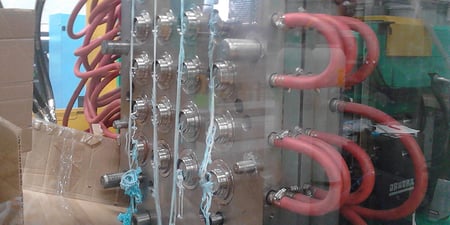Processing plastics whether that be with injection molding or any variety of extrusion applications can come with inherent challenges to the processor. Great amounts of time and energy are used from part concept all the way through the process of producing good quality parts for the customer at a sustainable margin.
There are of course many areas of focus such as tooling design, concept, mock-ups and qualifications, processing technology, and maintenance among several others. Each area faces different challenges throughout the course of producing a quality product.
Commercial purging compounds are a tool that can and should be used whenever possible to save money by reducing costs associated with material changes, color changes, contamination removal, shutdown and sealing, and of course screw pulls on the maintenance side.
I think it is important for a processor to understand some of the root causes of issues they deal with on a daily basis. Looking more at the processing side of plastics is where you find engineers and techs dealing sometimes daily with the same types of issues. Issues can include long changeover times, excessive scrap, process irregularities, and carbon contamination just to name a few. When we look at color changes I know as a former processor myself that certain applications will continuously bring about the same type of issues on every run. Processors take note of any changes with material or process and diagnose the problem from there often solving the problem for that run. Unfortunately, that issue will likely pop up again after a shutdown or the next time that application runs. Most times it can be extremely helpful to have an idea of what the root cause is for a certain defect or problem.
With color issues many factors can come into play but as a purge rep now for several years I have seen patterns emerge with color issues. More often than not layering from previous materials or colors will be the culprit. Without a good purging program in place at your facility layering can cause several issues such as increased color or material changeover times, excessive scrap during changeovers, and even quality issues during the run that is impossible to predict.
Layering happens mostly on barrel walls and over time several different resins or the same resin in different colors can create layers that will degrade with time. You could see this present as black specs or carbon contamination that could “break loose” from the barrel wall and become part of the next few shots. Most process techs I speak with have witnessed a scenario where while running parts of a certain color a completely different color that was run previously breaks loose and contaminates the product. This can be tough to deal with since you never know when that may happen.
The good news is that layering can be prevented before it has a chance to take hold. We recommend using Asaclean for each material and color change so that any previous material is purged completely out of the barrel where each new run can start fresh with a clean barrel. Production resins are not designed to clean, scrub, or flush other materials. Resin can stick to metal surfaces and will tend to stay there until it is either purged or degraded enough to cause issues. A good commercial purging compound such as Asaclean is engineered to have a low affinity to metal and will purge out any material or contamination that is layered in the system. Reach out to us here at Asaclean and speak to one of our excellent Technical Sales Reps who can help you develop and implement a purging program at your facility.
Ready to try a preventative purge program yourself? Request a free 10-minute consultation here.








Comments